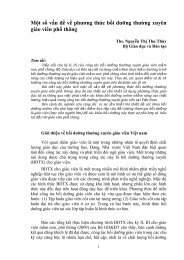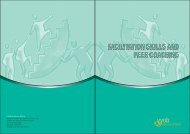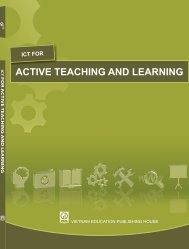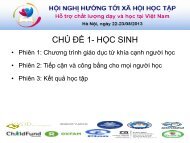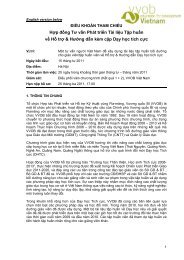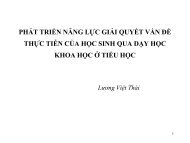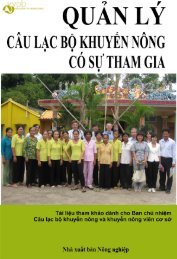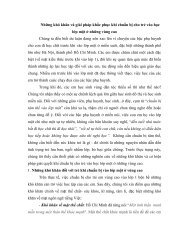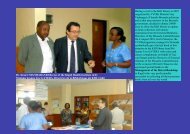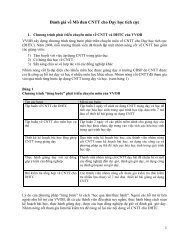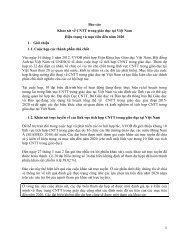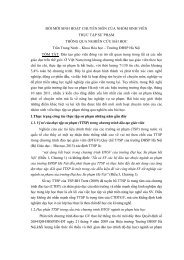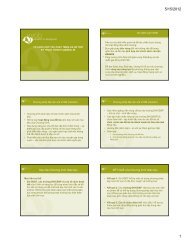Kenya Multi-Year Programme 2011-2013 - VVOB
Kenya Multi-Year Programme 2011-2013 - VVOB
Kenya Multi-Year Programme 2011-2013 - VVOB
- No tags were found...
You also want an ePaper? Increase the reach of your titles
YUMPU automatically turns print PDFs into web optimized ePapers that Google loves.
6.4.3.3. Description of target groupsDesigned as a broad ranging intervention, the Healthy Learning programme aims to benefit severaltarget groups, including education managers, teachers, and relevant stakeholders by strengtheningtheir capacity to support primary schools in quality learning, health and nutrition.The target beneficiary group consists of primary school children (and indirectly their communities),mainly in Arid and Semi-arid areas (ASAL) and in ―pockets of poverty‖, who often face physical andcultural barriers to education. Those targeted by the programme exhibit low enrolment and attendancerates, high drop-out rates and low academic achievement. Barriers include household labourdemands, diminutive value for education by parents, short-term hunger and nutritional deficits, all ofwhich compromise participation in the classroom. Healthy Learning supports the quality and relevanceof education in primary schools, particularly for girls and children living in poverty and food insecurity.In <strong>Kenya</strong>, schools are also seen as local institutions that provide a strong entry point into thecommunity, and disadvantaged communities are indirect beneficiaries of the Healthy Learningprogramme.6.4.3.4. Analysis of the strategyThe chosen strategy of supporting capacity strengthening at differerent levels was found to beeffective in Phase I of the Healthy Learning programme.This intervention strategy is supported by national policies, which helps in getting support from seniormanagement. The National School Health Policy, produced by the Ministry of Education and theMinistry of Public Health and Sanitation, is cross-sectoral, and includes a section on nutrition, outliningschool nutrition services, nutrition education, school feeding, and community involvement.As indicated in chapter 6.4.2.2, the chosen strategy for Healthy Learning is in support of governmentaction to deliver improved and cost-effective health, nutrition, agricultural and environmental educationto primary schools in <strong>Kenya</strong>. Healthy Learning will continue to work at different levels (national, districtand school level). The result areas in Phase II remain largely the same as in Phase I, but have beenreformulated to better reflect the changing environment and alignment with the national policies.A more detailed analysis of the strategy per result area is given below.Result 1Ministry of Education staff involved in the Investment <strong>Programme</strong> “School Health, Nutrition & Meals” ofthe <strong>Kenya</strong> Education Sector Support <strong>Programme</strong> (KESSP) coordinates, harmonizes, advises on andsupports initiatives promoting “Healthy Learning”.The programme aims to support the responsible Units at MOE Head quarters to improve planning andimplementation, as well as improve coordination of various initiatives at different levels (national,district, school level) related to School Health, Nutrition and Meals.In the early years of KESSP I (2005-2010/<strong>2011</strong>), the investment programme on ―School Health,Nutrition & Meals‖ 16 was mainly focused on school feeding. With an increase in initiatives on Healthand Nutrition (from MOE and other ministries such as Health, Agriculture), and their link withsustainable school meals, the ministry staff was challenged to capture and coordinate these efforts inorder to achieve the objectives of the education sector.In the first phase (2008 – 2010), the MOE Head office staff in charge of School Health, Nutrition andMeals successfully increased their capacity, through the programme, to cope with these demands.This approach will be continued in the second phase. Therefore, the first component of the HealthyLearning sub programme aims to increase the capacity of the staff at headquarters (currently 6professionals) to cope with new and emerging demands. Ministry of Education staff members who16 The School Feeding <strong>Programme</strong> has been renamed School Meals <strong>Programme</strong>, in line with international trends,<strong>Kenya</strong> - <strong>Multi</strong>-<strong>Year</strong> <strong>Programme</strong> <strong>2011</strong>-<strong>2013</strong> 56/148



